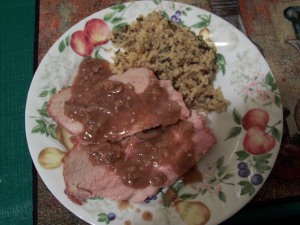English food culture has been beef-based for a long time; at least as long as horses were able to replace oxen as draft animals. When English people came to America as colonists, they brought with them several culinary expectations, one of which was that beef would continue to be the center of their dietary experience.
Unfortunately, things didn’t quite work out that way. The cattle the settlers brought over with them had a lot of trouble adapting to the new climate and new sources of food (cows can be pickier than people when it comes to that kind of thing), and maintaining a stable cow population was rough going for a while. Instead, the settlers turned to a heretofore undervalued resource: the pig. Unlike cows, pigs really don’t care what they eat, breed quickly, and are smart and clean enough not to require a whole lot of attention. Pigs took to the New World so well, in fact, that they became something of a local nuisance with half-feral hogs breaking down fences, digging up crops, and attacking people in the street (needless to say, early Colonial promotional literature stays diplomatically silent on the subject of vicious gangs of rogue pigs, though court documents paint a horrifying picture of the porcine criminal class).
Wether because of their reputation as violent walking garbage disposals, or simple Anglo-Norman culinary preference (food snobbery is a universal human trait, but it’s worth noting that hog is one of only eight wholly Celtic words remaining in the modern English language), Pigs were traditionally a “lower class” meat source in Britain. Fortunately, self-preservation is also a universal human trait, and pork became a staple source of meat and fat for all classes in America until beef could reliably be acquired. By the 18th Century, Americans and American foodways were undergoing a very conscious process of Anglicization as colonists tried to demonstrate their cultural solidarity with the Mother Country by buying and eating British (and as Chris Onstad says, there’s nothing more British than a man sick on beef), but pork remained a staple element of the American diet to a degree that set it apart, especially in the Chesapeake and Deep South.
As to what you’d actually be eating if you stopped for a bite back then, Hannah Glasse suggests this method of roasting:
Pork must be well done, or it is apt to surfeit. To every pound allow a quarter of an hour…When you roast a loin, take a sharp pen-knife and cut the skin across, to make the crackling eat the better…. Roast a leg of pork thus: take a knife, as above, and score it; stuff the knuckle part with sage and onion, chopped fine with pepper and salt: or cut a hole under the twist and put the sage &c. there and skewer it up with a skewer. Roast it crisp, because most people like the rind crisp, which they call crackling.
For modern purposes this version of Hannah Glasse’s original, from Lobscouse and Spotted Dog, is excellent:
Roast Pork
- 1 half leg of pork with skin, about 8 lbs
- 1 tbs fresh sage
- 1 recipe Sage and Onion Stuffing
- Flour for dredging
Preheat oven to 450 degrees. Bone the pork (if necessary) and sew or skewer one end together to make a pocket for the stuffing. Spoon stuffing into the cavity and sew or skewer opening. Using twine or string, tie roast into a an oblong package. Dredge with flour and place in oven. Immediately reduce heat to 350 degrees and roast for about an hour.
Remove roast from oven and carefully score skin in one-inch squares. Tear sage into small pieces and stuff into cuts. Return to oven and roast for two more hours, or until it reaches an inside temperature of 160 degrees. Let rest at least 15 minutes before carving.
Sage and Onion Stuffing
- 1 large onion, peeled
- small handful fresh sage
- 1/4 lb stale French bread, crumbled
- 1 tsp dry mustard
- 1 egg
- salt and pepper
Blanch onion in boiling water for five minutes. Add sage and cook 30 seconds more. Strain and chop coarsely. Add bread, mustard, egg, and salt and pepper to taste. Mix well. Makes enough for an 8 lb roast.
The mustard adds a definite bite to this one. For authentic tavern fare, serve it with some applesauce or brown onion sauce, and perhaps some Carolina rice. Or cheat and use wild rice.


Leave a comment